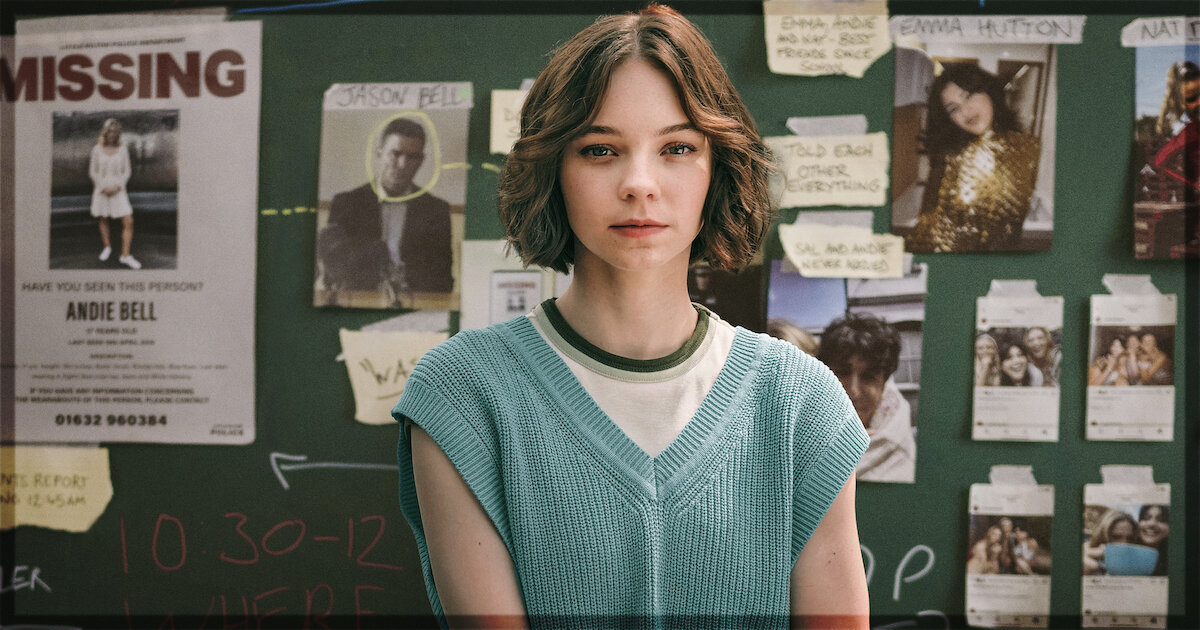In 2019, author Holly Jackson released the YA fiction novel A Good Girl’s Guide to Murder to critical acclaim. It went on to win 2020’s British Book Awards Children’s Fiction Book Winner of the Year and, as with most award-winning novels, it was soon picked up for a television adaption. The book follows seventeen-year-old Pippa “Pip” Fitz-Amobi as she investigates the apparent murder-suicide of Sal Singh, whose supposed victim was girlfriend Andie Bell, which occurred five years prior. The BBC adaptation follows a similar path to the novel, with the protagonist remaining in the fictional Buckinghamshire village of Little Kilton (although for American audiences, the novel was set in Fairview, Connecticut).
The summer holidays are seemingly in full swing for Pip (Emma Myers), whose timidity is only superseded by her inquisitiveness. With her eyes set on Oxbridge University, she has to do an Extended Project Qualification (EPQ) over the summer for admission next year. For her, and for the residents of the quaint British village Little Kilton, the deaths of Andie (India Lillie Davies) and Sal (Rahul Pattni) is the only big drama that has disturbed the status quo of the village – the village itself is the kind of nondescript conservative-minded middle-class idealism where the working class don’t seem to exist. So when Pip sets her sights on proving Sal innocent as part of her EPQ, ripples start spreading from the epicenter of her investigation. She is not actively trying to reopen wounds, but the naive young investigator can’t quite let this go. The case has a hold over her due to her own interactions with Sal from when she was 12 years old. She is joined on her investigation by spritely young Ravi (Zain Iqbal), Sal’s younger brother, and who becomes a love interest.
There’s a distinct lack of place in Dolly Wells‘ TV adaptation of A Good Girl’s Guide to Murder. It’s strangely anachronistic, playing around with its sense of geography. While it is confined to a village in Britain – the middle-class cobbles and gastro pubs infiltrate the periphery of establishing shots – there is a real sense of Americanism to the show’s setting. While Sex Education used this idea to displace viewers from thinking the education they deliver was relevant solely to residents of Britain, the use of it in A Good Girl’s Guide to Murder just makes the show feel flimsy, and lost in the details; ones that Pip can only stumble upon through luck and social media sleuthing.
The young Myers as Pip is charming enough – and has great chemistry with Iqbal – but her performance is a major factor in the extinguishing of authenticity here. An early scene in the series involves her taking shots of liquor to earn information from suspect Max (Henry Ashton); the seventeen-year-old doesn’t drink but knocks them back like the cold tea it probably was. As a grown-ass adult, I can’t think of a time that non-drinkers were able to down five “thimbles” of whisky – heck I don’t think I could do a single one without wanting to gag. Unfortunately the shots taken are a succinct summation of the show: fake, tepid and lacking the acrid bite needed for a story about topics of this ilk.
While shows that revolve around teenagers can’t all be as salacious and provocative as Skins, this is a show that orbits more adult material without engaging with it, accidentally reinforcing the idea that older teenagers aren’t raging balls of hormones. A subplot involves the leaking of nudes, while the overarching mystery is the solving of a murder-suicide, but there is a timidity and youthfulness not quite befitting of the topics at hand. It then all feels too disposable. When the latter season revelations occur like a Harlan Coben novel (Holly Jackson novel, in time perhaps), you’re left feeling like you’re watching children playing “grown-up”: you never really believe it. The Guardian once called the 2019 novel “elegantly plotted,” which is a far departure as a description for this adaptation.
A Good Girls Guide to Murder is a whodunnit where Nancy Drew meets Paper Towns, by way of CBBC. It is syrupy, and sanitsed to the point of being interminably slight. Zestily lurching forward with a resoundingly twee spirit, it mimics the kind of spunky fare for young teens that was once commonplace at 3 pm on a weekday. But this show is as naive as Pip herself. It wants to have the best of both worlds but it is not mature enough to engage teenagers who will be striving for the more adult fare, but too inauthentic and daft for the adult audiences watching this wishy-washy YA adaptation that still has child lock switched on.
You might also like…
‘Paddington in Peru’ Review: Villain Centric Sequel Misses the Mark


